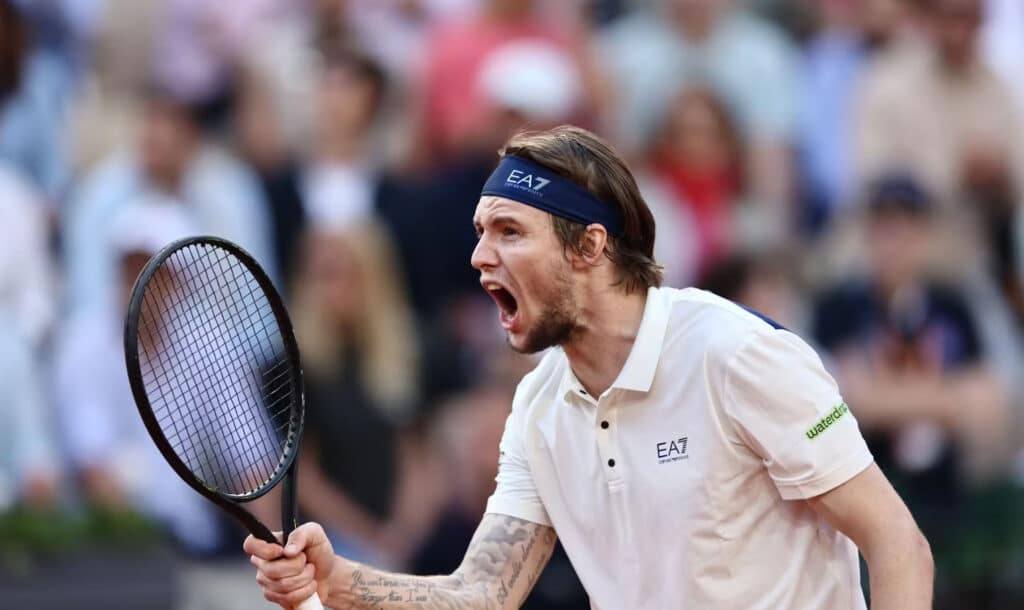Kazakh maverick Bublik upsets world no. 5, reaches first Grand Slam quarterfinal

Photo: Rolandgarros.com
Alexander Bublik, Kazakhstan’s top player (ATP ranking No. 62), stunned Britain’s Jack Draper, the world No. 5, in four sets (5-7, 6-3, 6-2, 6-4) to reach the quarterfinals of the 2025 French Open, marking his first appearance in a Grand Slam quarterfinal.
McEnroe was half-right
Bublik continues to deliver surprises at this year’s Roland Garros. In the second round, he staged a dramatic comeback against world No. 9 Alex de Minaur of Australia, winning in five sets: 2-6, 2-6, 6-4, 6-3, 6-2. Against Draper, Bublik needed only four sets to eliminate another top-10 opponent.
Few expected Bublik to win either match. His opponents were too formidable, or so it seemed. Tennis legend John McEnroe, commentating for TNT Sports, praised Draper ahead of the fourth-round match:
«The guy’s in unbelievable shape. You see Jack Draper maturing, playing better and better on the spot. I’d be surprised if he doesn’t win multiple majors. It’s incredible how much he’s improving and how great a player he’s become. He can do everything.»
The 66-year-old former champion did briefly mention Bublik’s unpredictability but concluded that the 23-year-old left-hander from England should win comfortably. As it turned out, McEnroe was only half-right.
Unpredictable brilliance
Despite dropping the first set 5-7, Bublik began to figure Draper out quickly. The Briton’s blistering serve and commanding baseline game initially gave him the upper hand, but Bublik adjusted with style and precision.
And then came the drop shots. The same tactic that had dismantled De Minaur now confounded Draper. Bublik mixed feather-light drop shots with steady, precise baseline play, throwing his opponent off rhythm. Draper chased the ball to the net repeatedly, often in vain, and visibly grew frustrated. His confidence collapsed, and with it, his game.
Bublik, by contrast, only grew more inspired. Known for flashy one-off rallies that thrill tennis purists, he put on a complete performance under the lights on Court Suzanne-Lenglen. His creativity, timing and flair were on full display in a match that defied expectations and left fans wondering: what might he do next?
You had to see it!
Bublik broke Draper’s serve for the first time at the start of the second set, and that was effectively the beginning of the end for the British challenger. Draper, charging around the court with the intensity of a bull in a bullfight, looked ready to tear through his opponent. But Bublik played the matador.
Using Draper’s power against him, Bublik outmaneuvered the fifth seed with finesse and deception. He broke serve twice across the second and third sets. In the fourth, one early break, right in the opening game, was all he needed.
Who’s next: Sinner or Rublev?
It wouldn’t be a Bublik match without a bit of late drama. The final game stretched nearly 10 minutes, a tense back-and-forth that kept the Suzanne-Lenglen crowd on edge. But Bublik finally closed it out on his second match point, sealing the 5-7, 6-3, 6-2, 6-4 win after 2 hours and 34 minutes on court.
It’s a career-best result for the 26-year-old at Roland Garros. Before this run, he had never advanced past the second round in Paris.
Now, in his first Grand Slam quarterfinal, he awaits another major challenge: either longtime rival Andrey Rublev of Russia, ranked No. 15, or current world No. 1 Jannik Sinner of Italy.
While Bublik battles the world’s best, the junior tournament is also underway at Roland Garros. Kazakhstan’s Amir Omarkhanov and Zangar Nurlanuly both suffered opening-round losses in singles but will look to bounce back in doubles. Notably, Omarkhanov and his partner Santamarta Roig are the tournament’s No. 1 seeds.
The French Open, the second Grand Slam tournament of the season, traditionally caps off the spring clay-court circuit. The 2025 edition features:
- 128 players in each singles draw.
- 64 pairs in men’s and women’s doubles.
- 32 teams in mixed doubles.
Men’s singles matches are best-of-five sets; all other categories play best-of-three. In deciding sets, tie-breaks are played to 10 points instead of the standard 7.
This year’s prize fund is a record €56.3 million, the largest in French Open history.

